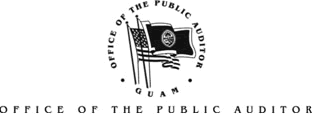
FY 2004 Financial Highlights
July 8, 2005
This is the first opportunity in which the Office of the Public Auditor (OPA) has been involved with the issuance of the financial audit of the Guam Housing and Urban Renewal Authority (GHURA), a component unit of the Government of Guam. In the past, GHURA’s prior management did not recognize the authority of the OPA to monitor and issue all financial audits pursuant to 1 G.C.A. §1908.
As a housing authority, GHURA is responsible for providing assistance to low-income families through various community development block grants, community housing programs and projects for low-income public housing, Section 8 housing choice vouchers, and elderly housing. GHURA has partnered with several government agencies and non-profit organizations to provide funding for the construction of a variety of community facilities throughout the island. These partners include the Department of Public Health and Social Services, Senior Citizens’ Division; the Department of Education Head Start Program; Sanctuary; and Catholic Social Services.
Major programs administered by GHURA and funded by the U.S. Department of Housing and Urban Development (HUD) include:
- Section 8 is a Housing Choice-Voucher Program (HCVP) that provides
vouchers and certificates to eligible low-income families, the elderly,
and persons with disabilities. GHURA can service up to about 2,515 households
with the $32 million grant.
- The Community Development Block Grants (CDBG) are used to revitalize
neighborhoods, provide affordable housing, expand economic opportunities,
and improve community facilities and services.
- The Low Income Housing Program is an affordable public rental-housing
program for eligible low-income families, the elderly, and persons with
disabilities. GHURA has 750 public housing units located throughout
Guam.
- The Guam Elderly Housing Project (Guma Trankilidat) is financed through a Farmers Home Administration loan, provides housing to the low-income elderly and persons with disabilities. The project contains 49 one-bedroom units located in Tumon. Section 8 rental assistance is also provided to residents of Guma Trankilidat.
In fiscal year 2004, according to the financial audit conducted by J. Scott Magliari & Company, total revenues were $43.9 million, an increase of $6.1 million or 16.2% from revenues of $37.8 million reported in 2003. The majority of GHURA’s revenues, about $42.4 million or 96.6% comes from HUD for various housing assistance programs.
GHURA had total expenditures of $43.8 million in fiscal year 2004, an increase of $5.3 million or 13.8% more compared to expenditures of $38.5 million reported in 2003. Rental payments to landlords were $30.3 million compared to $25.2 million last year, an increase of $5.1 million or 20.1%.
GHURA reported a positive change in net assets (income) of $137,540 compared to the loss of $689,128 in fiscal year 2003. Investments were $5.4 million, which increased slightly by $52,193. At the end of the year, total net assets were reported at $45.2 million due to an adjustment of $1.5 million from previously owned capital assets that were subsequently transferred to non-profit organizations. According to the external auditors, the adjustment was required of GHURA by HUD.
While GHURA had a slightly improved financial position in 2004, significant improvements still need to be made in internal controls and compliance. A total of 27 findings were identified of which 19 findings were problems previously identified in prior audits. The reoccurrence of these problems seem to indicate that GHURA has not fully addressed these deficiencies.
Twelve or nearly half, of the 27 findings were identified as material weaknesses. A reportable condition is a significant deficiency in internal controls and a material weakness is a reportable condition that may result in an error that could have the effect of changing the assessment of the government’s finances. The increase in the 12 material weaknesses identified compared to the six identified in 2003, raises grave concerns as to GHURA’s ability to monitor and administer HUD’s housing programs according to regulations. Examples of the material weaknesses identified include:
- Problems with aspects of client eligibility for re-evaluating family
income and composition annually, verification of third-party documentation,
and making the appropriate adjustments to the housing assistance payment
(HAP) and tenant rent as needed.
- Problems with applying two payment standards, one with utilities and
one without utilities. The auditors identified about $23,564 HAP overpayments
and extrapolated that potential questioned costs could be as high as
$1.9 million for fiscal year 2004. HUD has already identified the same
deficiency, which GHURA estimates to be approximately $1.5 million.
GHURA is negotiating with HUD to reduce the effect to about $700,000.
- Problems with calculating the total tenant payment (TTP) due to or
due from Family Self-Sufficiency (FSS) clients because FSS accounts
are not examined at either every re-certification or interim period
and changes to the client’s income are not reported to FSS in
a timely manner.
- Problems with developing adequate policies and procedures to ensure proper segregation of duties and the prevention and detection of fraud for the Automated Clearing House (ACH) electronic fund transfers to landlords. The lack of controls places GHURA at risk for potential loss of cash due to fictitious landlords and/or tenants. The auditors made 15 recommendations for improving and safeguarding this process.
For a more detailed commentary of GHURA’s operations, refer to
the Management’s Discussion and Analysis in the audit report.